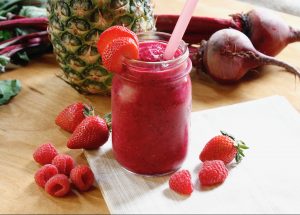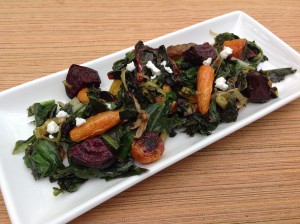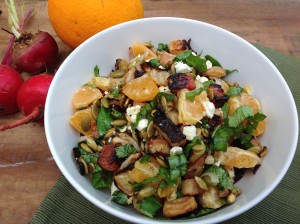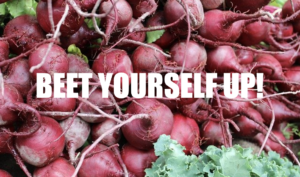 If you are not regularly eating this vegetable, there is a long list of reasons why you should start…NOW!
If you are not regularly eating this vegetable, there is a long list of reasons why you should start…NOW!
We are talking about BEETS!
When we talk about beets, we frequently hear people say things like “oh, I don’t like beets” or “you mean those jelly-like things on the salad bar?” or even “they taste like dirt.”
If this sounds like you, or someone you know, please humor us and be open-minded…we are here to tell you beets can taste absolutely fantastic! Learning how to prepare fresh beets will give you results that will completely outshine the salad bar variety!
Plus, beets are absolutely loaded with nutrients, and we are not talking about just a few vitamins and minerals…
they provide HUGE health benefits!
- With only 60 calories, one cup of beets has 4 grams of fiber, 2.5 grams of protein, plus folate, manganese, potassium, iron, and vitamins C and B, plus so much more!
- Beets are high in disease fighting phytonutrients, cancer-potective antioxidants, plus many other vitamins and minerals.
- They are filled with anti-inflammatory compounds (such as betaine) that regulate inflammation in the cardiovascular system and help reduce cholesterol and blood pressure.
- Both the roots and beet greens promote eye health.
- Beets contain compounds called gluthiones, which have been called “the mother of all antioxidants” and help cleanse the blood of toxins and waste and provide tremendous benefits for the liver and other parts of our digestive system.
- Beets also contain nitrates that help boost energy and performance and high-performance athletes have made beets an integral part of their diets!
- Beets also help boost performance in other areas…if you know what we mean!
With all of these benefits, how can they NOT be part of your regular routine?!
In season right now!
Beets are generally available year round, but are at their best starting NOW! Beginning in June and running through October is the best time to enjoy fresh beets, so be on the lookout for them at your local farmers’ markets. There are several types of beets and they are NOT all red!
 Red beets – probably the most common variety, they have a deep red color and can stain your hands when preparing them in the kitchen (but don’t worry, the red color easily washes away, and if it doesn’t, lemon juice will also help remove the stain).
Red beets – probably the most common variety, they have a deep red color and can stain your hands when preparing them in the kitchen (but don’t worry, the red color easily washes away, and if it doesn’t, lemon juice will also help remove the stain).- Golden beets – slightly milder than red beets, golden beets are a bright orangish-yellow color.
- Chioggia beets – naturally striped similar to a candy cane, these tend to be the sweetest variety. Keep in mind, the striped pattern will fade or disappear when the beets are cooked.
- White beets – these beets look similar to turnips, and are not quite as sweet as the other varieties.
For the sneaky chefs out there…
a great trick is using golden, chioggia or white beets in recipes if you don’t want it to be noticeable the beets are there. Making the flavor-popping Roasted Beet Hummus with golden beets is ideal because it packs the nutrition of beets without tipping off your eaters there is a “suspicious ingredient” involved! The beets also give the hummus an amazing flavor!
How do you prepare them?
 Raw! Beets can be eaten raw. They are great added to smoothies, such as in our Super Pink Strawberry Raspberry Smoothie, or thinly sliced as a topping on salads.
Raw! Beets can be eaten raw. They are great added to smoothies, such as in our Super Pink Strawberry Raspberry Smoothie, or thinly sliced as a topping on salads.
Roasted! When beets are cooked, they get softer and sweeter. You can steam beets, but our favorite way to cook beets is to roast them in the oven (you knew we would say that, didn’t you?)! Pairing roasted beets with a spicy green (like arugula), a soft cheese (like goat cheese) and toasted nuts is guaranteed to make you fall in love! The Roasted Beet Orzo Salad is a favorite among Eat REAL America members! Here are some other tips:
- Like most roasted vegetables, beets will caramelize and be bursting with flavor when roasted in the oven. All you need is a little olive oil, salt and pepper to have great results!
- Roast them whole or in bite size pieces, and if you are worried about staining, line a baking sheet with foil or parchment paper, or wrap the whole beets in a foil packet.
- Roast beets in the oven at 400 degrees for 40-45 minutes if leaving them whole, or 25-30 minutes if chopped into 1/2 inch cubes or bite size pieces. You will know they are done when you can easily pierce them with a fork.
- Try not to overcook beets because they can begin to lose their nutrients. As long as you are not roasting beets longer than 60 minutes or steaming longer than 15 minutes, they will retain most of their nutrients.
- Salt can affect the color of your beets…if you are trying to retain the most vibrant color, add the salt at the end of your cooking.
To peel or not to peel?
Believe it or not, peeling is completely optional! Simply rinse the beets well, pat dry, trim the ends and any rough spots, then proceed — but you can leave the peel on!
How to store beets?
It’s best to cut the greens and stems from the beet root (or the round beet) so they don’t pull moisture from the beet. You can leave about 2 inches of the stem and you don’t need to wash the beets before storing. Place beets in a plastic bag, wrapping tightly and removing most of the air, and store in the refrigerator for about 3 weeks. Raw beets do not freeze well because they can get soft upon thawing, but cooked beets will freeze beautifully — they will retain their flavor and texture.
What do you do with the greens?
 Beet greens are also filled with nutrients and are edible. You can use them interchangeably with Swiss chard or other dark greens. They can be sautéed or added to cooked dishes and will wilt just like spinach.
Beet greens are also filled with nutrients and are edible. You can use them interchangeably with Swiss chard or other dark greens. They can be sautéed or added to cooked dishes and will wilt just like spinach.
What about beet sugar?
It may sound like a healthy ingredient, but beet sugar typically is highly processed and has lost much of its nutritional value. There is no significant difference between beet sugar and cane sugar…as always, use all sugars in moderation!
Don’t worry about the after-effects!
Not to get too personal, but if you are not already, you should be aware that red beets can stain more than just your hands. You may see beet stains for a few days later as you pass your digested food and liquids (yep…we are going there!). So, if you are eating red beets, don’t freak out that there is something else going on…it just means you are regular and the color is there to prove it!
Be aware — like rhubarb, beets contain oxalates, naturally occurring organic acids, which should be restricted with certain medical conditions. It is best to consult with your doctor if this is a concern.
 Try these great-tasting beet ideas and see if you will be a beet-believer!
Try these great-tasting beet ideas and see if you will be a beet-believer!
We would love to hear from you – what are your favorite ways to enjoy beets?
Roasted Beets and Orange Salad
Pasta Primavera with Grilled Sausage
Chermoula Inspired Roasted Vegetables and Chickpeas
 LEARN MORE ABOUT THE NAPKIN!
LEARN MORE ABOUT THE NAPKIN!



Leave A Comment